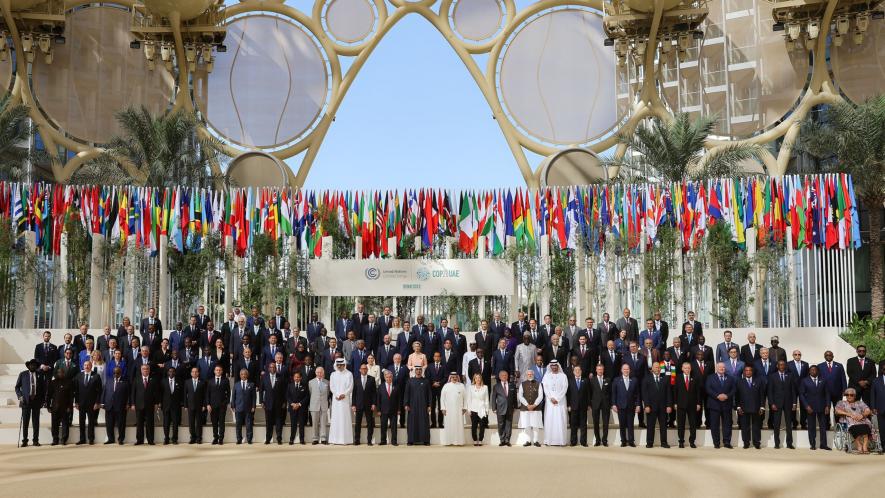COP28: Lofty Aims but Lot Depends on Action

Image Courtesy: Twitter/@COP28_UAE
The annual climate summit is upon us. COP28 in Dubai from November 30 to December 12, 2023 is a milestone event, since it will take up the first five-yearly Global Stocktake (GST) to assess where the world stands with regard to decisions taken under the Paris Agreement (PA). The GST covers mitigation, adaptation, financing and other support to developing countries. Yet, given the menacing levels reached by impacts of climate change the world over, and the huge under-performance in reducing global emissions as necessary, measures and mechanisms to urgently and adequately bring emissions down sharply as dictated by science, should dominate COP28. But will it?
The year 2023 is almost certain to be the hottest year on record in perhaps the hottest decade. Global average temperature this year is likely to reach or cross 1.5 degrees C above pre-industrial levels, and went past 2C for the first time ever just a few days back on November 17. Compared with the global goal of restricting warming to well below 2C, preferably 1.5C, all indications are that temperature rise could be 2.5-2.9C as per current trends.
Already, major extreme weather events are being witnessed frequently across the world, a new normal causing enormous damage and human misery: heat waves, forest fires, droughts, devastating floods, melting of polar ice and glaciers, sea-level rise. Authoritative reports of the Inter-governmental Panel on Climate Change (IPCC) state that some climate impacts such as sea-level rise and ice-melt may have gone beyond adaptive limits, and are close to becoming irreversible.
Global Stocktake
The GST process began in 2020 and culminates at COP28. A detailed report of the GST Tehnical Dialogue on GST (GST TechRep) with inputs from many state- and non-state stakeholders and a UN GST Synthesis Report (GST SynRep) have been released in recent month as inputs to COP28.
Based on the GST review here, emissions reduction targets in the voluntary Nationally Determined Contributions (NDC) submitted by all countries under PA, and upgraded at COP26 in Glasgow in 2021, are to be revised upwards and updated NDCs are to be submitted starting March-April 2025 and agreed at COP30 that year.
The dire need for urgent, deeper emissions cuts has been highlighted in these GST assessment documents as well as by the UN Environment Programme (UNEP) annual Emissions Gap Report 2023 (EGR) 2023 released on the eve of COP28.
Even if all current NDCs are achieved, greenhouse gas (GHG) emissions in 2030 would be 14 Gt (Gigatons or billion tons) and 22 Gt higher than they should be for 2C and 1.5C, respectively.
Global emissions in 2030 need to be 28% less than 2019 levels for 2C, and 42% less for 1.5C, compared with 2% less as per current NDCs. A huge step-jump is, therefore, required in the next round of NDCs with 2035 as target year. EGR projects that global emissions, slated to be 56Gt in 2035, should be 36 Gt (35% lower) and 25 Gt (55% lower) for 2C and 1.5C, respectively. A long way to go!
Both GST Tech Rep and EGR have also clarified on the much-touted “net-zero” carbon dioxide (CO2) emissions goal for 2050, adopted by many Western countries and hyped up by international NGOs, and even the UN Secretary General, who have posed this as a target for all countries. The reports state that net-zero 2050 pathways of most countries are not credible. Further, the target called for is really global not national net zero CO2 emissions in 2050, with “developed countries to reach net-zero considerably earlier than the global average.”
Clearly, developed countries should be making the deepest cuts. The GST at COP28 is the fit occasion to push hard to outline the emissions cuts required and initiate the process towards updated NDCs by COP30 in 2025. In the considerable time available, updated draft NDCs could be iteratively tabled, assessed for adequacy for 1.5C or 2C, and revised as needed till the goal is seen to be reached. However, the current state of play and the roles of certain actors make this a steep uphill task and possibly an unlikely outcome at COP28.
Developed Countries and Fossil-Fuel Lobby
Developed countries will probably try every trick in the book to evade responsibility. Several Western leaders, including US President Biden, are staying away from COP28. Many of them, including “green champions” EU, Germany, and the UK, besides laggard US and several allies, are backsliding even on their PA commitments, already about 20% lower than earlier promises.
Coal-based electricity is being revived and the case for natural gas (also a fossil fuel) as a “transitional fuel” is being drummed up, citing the Ukraine war and an economic downturn as rationale. Many oil and gas producing countries are following suit, actively supported by the fossil fuel industry, which has now established a large and powerful non-government presence at the COPs, and is likely to play a big role in Dubai.
The President of COP 28, Dr. Sultan Al-Jaber is himself MD and CEO of ADNOC, a leading Abu Dhabi oil producer, and the UAE Minister for Industry. He is now putting his considerable weight behind phasing down only “unabated oil,” i.e. without carbon capture and storage (CCS), which has huge uncertainties, and in support of “low-carbon” oil and “blue hydrogen,” again dependent on CCS, thus extending tolerance for fossil fuels.
A recent International Energy Agency report has said that the notion that oil extraction and processing with CCS can significantly reduce emissions is “pure fantasy.” ADNOC has also been investing in renewables, including in Africa, where it is building considerable support that may be reflected at COP28.
The question is who will put the requisite pressure on developed countries at COP28 through to COP30? China, the world’s largest emitter, has so far not wanted to rock the boat. India has long played a defensive role, refraining from challenging the US and its allies. India is already reducing emissions considerably, if moderately, for a developing country.
EGR 2023 has, in a rare mention, differentiated India from other large emitters by highlighting its low share of historical and current emissions, and low proportion of emissions relative to share of population. If needed, India still has considerable room to cut back on emissions growth since its NDCs are mostly confined to power generation and energy intensity, leaving room in several sectors such as transport and waste, and by stopping its current onslaught on forests and tribal rights.
Loss & Damage
Most least developed countries, small island states and the Africa bloc, an otherwise numerous and vocal group, along with many NGOs, have expended enormous energy and political capital over many COPs, finally securing an agreement at COP27 on a separate fund for Loss & Damage from developed countries to compensate for damage already done. But there are hard struggles ahead on definitions and mechanisms which remain to be wrestled with at COP28 and perhaps beyond. Will there be energy and momentum left for a big push for massive emissions cuts by the same big powers?
Financing is certainly a critical issue. Enormous sums, now estimated to run into several trillion dollars, are required to help developing countries decarbonise, adapt, and now compensate for damage done. Developed countries had earlier agreed to provide $100 billion annually, not counting L&D. Despite various claims that this target was finally reached last year, a para in the GST Tech Report makes clear that “in 2020 the real value of financial support by developed countries specifically aimed at climate action (emphasis added) was only around USD 21 billion to USD 24.5 billion, much less than the officially reported USD 83.3billion.”
Big differences remain on whether these funds should be only public or also include multilateral funding, loans etc. While a new L&D fund has been created, actual finance flows are limited and come from the same pockets whatever the terminology.
Developed countries can stretch these negotiations out and distract efforts away from emissions reductions. At COP28, a lot will depend on how strategically efforts on Loss & Damage are balanced with a forceful push on drastic emissions reduction.
Other issues
An interesting and promising subject up for discussion at COP28, with potential for concerted action, is an envisaged Global Goal for Adaptation. Obviously, defining common goals is not easy since each country has its own specificities and generalisations are difficult. How this unfolds at COP28 will be carefully watched.
India has much to learn here, but little to contribute since it has done little on adaptation domestically. India is the seventh worst climate-affected region, but has not even begun discussions towards a National Adaptation Plan, a goal repeatedly called for in the UNFCCC process. It is hoped that, aided by guidance at COP28, India would commence work towards a participatory, multi-stakeholder programme with full involvement of State governments, local self-government bodies and other peoples’ organisations.
Finally, various new sectoral plans, discussions and targets, may emerge at COP28, a trend begun at COP27 in Glasgow focused on methane, deforestation and electric vehicles. Unfortunately, India had stayed away from them except for EVs. In Dubai, discussions on health systems, and food systems including agriculture for the first time, are expected. Action on this front, too, would be watched with interest.
The writer is with the Delhi Science Forum and All India People’s Science Network. The views are personal.
Get the latest reports & analysis with people's perspective on Protests, movements & deep analytical videos, discussions of the current affairs in your Telegram app. Subscribe to NewsClick's Telegram channel & get Real-Time updates on stories, as they get published on our website.























